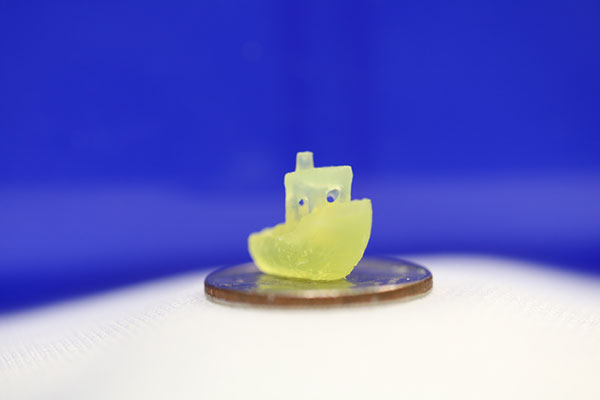Stanford Engineers Craft Novel Kind of 3D Printing
Dan Congreve, in electrical engineering at Stanford, and his colleagues have developed a way to print 3D objects within a stationary volume of resin.

A boat figurine made via a new 3D printing process that enables ability to print an object within a volume of resin rather than building the object layer by layer. Image courtesy of Dan Congreve.
Latest News
April 26, 2022
Though there have been countless innovations in 3D printing techniques over the last decade, the technology still must work with a fundamental limit: objects need to be built up layer by layer. But what if they don't?
Dan Congreve, an assistant professor of electrical engineering at Stanford and former Rowland Fellow at the Rowland Institute at Harvard University, and his colleagues have developed a way to print 3D objects within a stationary volume of resin. The printed object is fully supported by the thick resin, so it can be added to from any angle. This removes the need for the support structures typically required for creating complex designs with more standard printing methods. The new 3D printing system, which was recently published in Nature, may make it easier to print intricate designs while saving time and material, according to researchers.
“The ability to do this volumetric printing enables you to print objects that were previously very difficult,” says Congreve. “It’s a very exciting opportunity for three-dimensional printing going forward.”
Printing with Light
The researchers focused a laser through a lens and shone it into a gelatinous resin that hardens when exposed to blue light. But Congreve and his colleagues couldn’t just use a blue laser – the resin would cure along the entire length of the beam. Instead, they used a red light and some cleverly designed nanomaterials scattered throughout resin to create blue light at only the precise focal point of the laser. By shifting the laser around the container of resin, they were able to create detailed, support-free prints.
Congreve’s lab specializes in converting one wavelength of light to another using a method called triplet fusion upconversion. With the right molecules in close proximity to each other, the researchers can create a chain of energy transfers that, for example, turn low-energy red photons into high-energy blue ones.
“I got interested in this upconversion technique back in grad school,” Congreve said. “It has all sorts of interesting applications in solar, bio, and now this 3D printing. Our real specialty is in the nanomaterials themselves—engineering them to emit the right wavelength of light, to emit it efficiently, and to be dispersed in resin.”
Through various steps (which included sending some materials for a spin in a Vitamix blender), Congreve and his colleagues formed the necessary upconversion molecules into distinct nanoscale droplets and coated them in a protective silica shell. Then they distributed the resulting nanocapsules, each of which is 1,000 times smaller than the width of a human hair, throughout the resin.
“Figuring out how to make the nanocapsules robust was not trivial—a 3D-printing resin is actually pretty harsh,” says Tracy Schloemer, a postdoctoral researcher in Congreve’s lab and one of the lead authors on the paper. “And if those nanocapsules start falling apart, your ability to do upconversion goes away. All your contents spill out and you can’t get those molecular collisions that you need.”
Next Steps for Light-Converting Nanocapsules
The researchers are currently working on ways to refine their 3D-printing technique. They are investigating the possibility of printing multiple points at the same time, which would speed up the process considerably, as well as printing at higher resolutions and smaller scales.
Congreve is also exploring other opportunities to put the upconverting nanocapsules to use. They may be able to help improve the efficiency of solar panels, for example, by converting unusable low-energy light into wavelengths the solar cells can collect. Or they could be used to help researchers more precisely study biological models that can be triggered with light or even, in the future, deliver localized treatments.
“You could penetrate tissue with infrared light and then turn that infrared light into high-energy light with this upconversion technique to, for example, drive a chemical reaction,” says Congreve. “Our ability to control materials at the nanoscale gives us a lot of really cool opportunities to solve challenging problems that are otherwise difficult to approach.”
Additional Stanford co-authors of this research are postdoctoral scholar Tracy Schloemer; former visiting researcher Michael Seitz; and graduate student Arynn Gallegos. Other co-authors, including a co-lead author, are from the Rowland Institute at Harvard University.
This research was funded by the Rowland Institute at Harvard University, the Harvard PSE Accelerator Fund, the Gordon and Betty Moore Foundation, an Arnold O. Beckman Postdoctoral Fellowship, the Swiss National Science Foundation, the National Science Foundation, and a Stanford Graduate Fellowship in Science & Engineering (a Scott A. and Geraldine D. Macomber Fellowship).
Sources: Press materials received from the company and additional information gleaned from the company’s website.
Subscribe to our FREE magazine, FREE email newsletters or both!
Latest News
About the Author
DE’s editors contribute news and new product announcements to Digital Engineering.
Press releases may be sent to them via [email protected].






